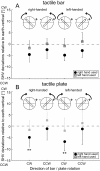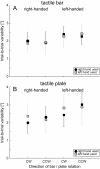Hysteresis of haptic vertical and straight ahead in healthy human subjects
- PMID: 22998034
- PMCID: PMC3505461
- DOI: 10.1186/1471-2202-13-114
Hysteresis of haptic vertical and straight ahead in healthy human subjects
Abstract
Background: The subjective haptic vertical (SHV) task requires subjects to adjust the roll orientation of an object, mostly in the roll plane, in such a way that it is parallel to perceived direction of gravity. Previously we found a tendency for clockwise rod rotations to deviate counter-clockwise and vice versa, indicating hysteresis. However, the contributing factors remained unclear. To clarify this we characterized the SHV in terms of handedness, hand used, direction of hand rotation, type of grasping (wrap vs. precision grip) and gender, and compared findings with perceived straight-ahead (PSA). Healthy subjects repetitively performed adjustments along SHV (n = 21) and PSA (n = 10) in complete darkness.
Results: For both SHV and PSA significant effects of the hand used and the direction of rod/plate rotation were found. The latter effect was similar for SHV and PSA, leading to significantly larger counter-clockwise shifts (relative to true earth-vertical and objective straight-ahead) for clockwise rotations compared to counter-clockwise rotations irrespective of the handedness and the type of grip. The effect of hand used, however, was opposite in the two tasks: while the SHV showed a counter-clockwise bias when the right hand was used and no bias for the left hand, in the PSA a counter-clockwise bias was obtained for the left hand without a bias for the right hand. No effects of grip and handedness (studied for SHV only) on accuracy were observed, however, SHV precision was significantly (p < 0.005) better in right-handed subjects compared to left-handed subjects and in male subjects.
Conclusions: Unimanual haptic tasks require control for the hand used and the type of grip as these factors significantly affect task performance. Furthermore, aligning objects with the SHV and PSA resulted in systematic direction-dependent deviations that could not be attributed to handedness, the hand used, or the type of grip. These deviations are consistent with hysteresis and are likely not related to gravitational pull, as they were observed in both planes tested, i.e. parallel and perpendicular to gravity. Short-term adaptation that shifts attention towards previous adjustment positions may provide an explanation for such biases of spatial orientation in both the horizontal and frontal plane.
Figures






Similar articles
-
Psychophysical Haptic Measurement of Vertical Perception: Elucidating a Hand Sensory Bias.Neuroscience. 2022 Jan 15;481:21-29. doi: 10.1016/j.neuroscience.2021.11.037. Epub 2021 Nov 29. Neuroscience. 2022. PMID: 34848259 Free PMC article.
-
Precision and accuracy of the subjective haptic vertical in the roll plane.BMC Neurosci. 2010 Jul 14;11:83. doi: 10.1186/1471-2202-11-83. BMC Neurosci. 2010. PMID: 20630097 Free PMC article.
-
Does gravity influence the visual line bisection task?J Neurophysiol. 2016 Aug 1;116(2):629-36. doi: 10.1152/jn.00312.2016. Epub 2016 May 25. J Neurophysiol. 2016. PMID: 27226452 Free PMC article.
-
The haptic perception of spatial orientations.Exp Brain Res. 2008 May;187(3):331-48. doi: 10.1007/s00221-008-1382-0. Epub 2008 Apr 30. Exp Brain Res. 2008. PMID: 18446332 Free PMC article. Review.
-
Gravity in the Brain as a Reference for Space and Time Perception.Multisens Res. 2015;28(5-6):397-426. doi: 10.1163/22134808-00002471. Multisens Res. 2015. PMID: 26595949 Review.
Cited by
-
The Subjective Visual Vertical and the Subjective Haptic Vertical Access Different Gravity Estimates.PLoS One. 2015 Dec 30;10(12):e0145528. doi: 10.1371/journal.pone.0145528. eCollection 2015. PLoS One. 2015. PMID: 26716835 Free PMC article.
-
Anchoring in action: manual estimates of slant are powerfully biased toward initial hand orientation and are correlated with verbal report.J Exp Psychol Hum Percept Perform. 2014 Jun;40(3):1203-12. doi: 10.1037/a0036217. Epub 2014 Mar 24. J Exp Psychol Hum Percept Perform. 2014. PMID: 24661067 Free PMC article.
-
Psychophysical Haptic Measurement of Vertical Perception: Elucidating a Hand Sensory Bias.Neuroscience. 2022 Jan 15;481:21-29. doi: 10.1016/j.neuroscience.2021.11.037. Epub 2021 Nov 29. Neuroscience. 2022. PMID: 34848259 Free PMC article.
-
The Tilted Self: Visuo-Graviceptive Mismatch in the Full-Body Illusion.Front Neurol. 2019 May 8;10:436. doi: 10.3389/fneur.2019.00436. eCollection 2019. Front Neurol. 2019. PMID: 31133959 Free PMC article.
-
Biases in the Visual and Haptic Subjective Vertical Reveal the Role of Proprioceptive/Vestibular Priors in Child Development.Front Neurol. 2019 Jan 7;9:1151. doi: 10.3389/fneur.2018.01151. eCollection 2018. Front Neurol. 2019. PMID: 30666230 Free PMC article.
References
-
- Barra J, Marquer A, Joassin R, Reymond C, Metge L, Chauvineau V, Perennou D. Humans use internal models to construct and update a sense of verticality. Brain. 2010;133(Pt 12):3552–3563. - PubMed
-
- Perennou DA, Mazibrada G, Chauvineau V, Greenwood R, Rothwell J, Gresty MA, Bronstein AM. Lateropulsion, pushing and verticality perception in hemisphere stroke: a causal relationship? Brain. 2008;131(Pt 9):2401–2413. - PubMed
Publication types
MeSH terms
LinkOut - more resources
Full Text Sources
Research Materials
Miscellaneous

